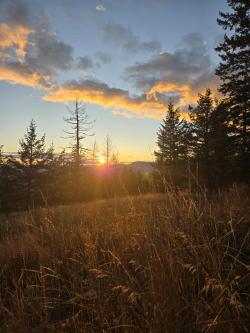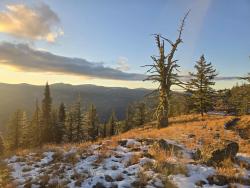ROSSLAND, B.C. — The Save Record Ridge Action Committee (SRRAC), a Rossland area community group, submitted additional expert evidence regarding the proposed Record Ridge mine to the B.C. government last week. The permitting process is now in its final stages, with a Ministry of Mining and Critical Minerals (MCM) decision expected this month. The group had anticipated that MCM would halt the process until the judicial review they filed last month over the province’s decision not to require an Environmental Assessment (EA) had been heard in court, but MCM has decided to press ahead even though the matter is before the B.C. Supreme Court.
The materials SRRAC has submitted warn of asbestos and other dust from the project, which is located about seven kilometres from the resort municipality of Rossland and even closer to the communities of Paterson and Big Sheep Creek. The package includes reports from two experts.
The first is an internationally recognized professor of atmospheric science from UBC with expertise in air pollution dispersion. He notes that “valley-bottom locations (including towns) will be subjected to accumulation of mine emissions” and that these conditions would prevail in summer when the mine will be operational. The expert points out that screening-level air dispersion modelling, which has not been done for this project, is the accepted technique for making an informed permitting decision, adding that the dust could contain trace amounts of possibly toxic metals and asbestos and that this should be explicitly investigated. Metals mentioned in the report are cobalt, nickel, and chromium.
The other is a registered professional engineer from the area with over 25 years of experience in workplace safety, drilling, blasting, materials handling, and hazardous materials (including asbestos and toxic metals). He raises numerous issues related to asbestos and other dust. For example, the engineer points to the company’s own data and details how variations in the deposit could lead to much higher local concentrations than the overall percentage that the company has been using. The engineer also uses a sample calculation to show how a blast intersecting one of the 6 mm veins the company reported could intersect hundreds of kilograms of asbestos, which could equate to trillions of fibres. His conclusion is that the assessment of and proposed measures for asbestos and other airborne contaminants are not adequate to assess risk, protect worker and public health, or support permitting for the Record Ridge project.
SRRAC is certainly not the only organization that has expressed concerns on this matter.
Interior Health has expressed concerns that dust may migrate into surrounding communities and has recommended that the project not go ahead.
Independently, 112 area physicians have signed and submitted a letter citing concerns with airborne particulates including asbestos and noting that a single asbestos fibre can be enough to cause mesothelioma, a lethal condition. The letter also states that superfine dust from the mine will affect people with asthma, cardiopulmonary disease, and other chronic conditions. SRRAC has repeatedly demanded a Human Health Risk Assessment, but there has not been one conducted for the mine.
The Washington State Department of Ecology had their own experts conduct a review of the project and sent a letter detailing their concerns, which include air quality impacts, to the B.C. government; it states they anticipate winds will carry dust into Washington State. The letter cites the U.S. Geological Survey, pointing out that typical serpentine deposits, like the rock at Record Ridge, typically contain 5 to 15 percent asbestos fibre by volume. They add that asbestos fibres do not degrade and can travel long distances before settling. The department also notes that the more toxic and carcinogenic hexavalent form of chromium may be present in the deposit.
Representatives from the Regional District of Kootenay Boundary as well as Rossland mayor and council have opposed the mine. Over two thousand people have signed petitions opposing the mine. Four of five Indigenous groups in the area have expressed concerns about the project. The lone Indigenous group that supports the project has publicly announced a business arrangement with the proponent.
The Ministry of Transportation and Transit has not even received an adequate transportation plan to use the Cascade highway, let alone approved one, and has assessed that the highway would not support mine traffic without major infrastructure upgrades.
“With no air dispersion modelling and so many issues related to asbestos and other dust, and with such broad opposition, we can’t see how the Ministry of Mining and Critical Minerals could possibly approve a permit,” said Melanie Mercier, spokesperson for SRRAC. “They are flying blind without the right data. And adding permit conditions or monitoring can't fix this.”
In their submission SRRAC asserts that it would be unreasonable, procedurally unfair, and unlawful for the province to issue permits for the mine at this point. The group has called on the province to require air dispersion modelling and rectify numerous other issues before any permits are issued.
For further information please visit saverecordridge.ca.
Attached photos are recent shots of Record Ridge, provided by SRRAC.

